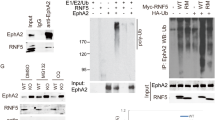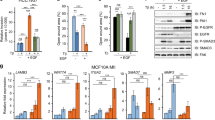Abstract
Because HER-2/neu overexpression is important in cancer development, we looked for a method of suppressing the cell transformation mediated by HER-2/neu overexpression. We have identified that the DNA-binding protein PEA3, which is encoded by a previously isolated gene of the ets family, specifically targeted a DNA sequence on the HER-2/neu promoter and downregulated the promoter activity. Expression of PEA3 resulted in preferential inhibition of cell growth and tumor development of HER-2/neu-overexpressing cancer cells. This is a new approach to targeting HER-2/neu overexpression and also provides a rationale to the design for repressors of diseases caused by overexpression of pathogenic genes.
This is a preview of subscription content, access via your institution
Access options
Subscribe to this journal
Receive 12 print issues and online access
$209.00 per year
only $17.42 per issue
Buy this article
- Purchase on Springer Link
- Instant access to full article PDF
Prices may be subject to local taxes which are calculated during checkout






Similar content being viewed by others
References
Park, J.B., Rhim, J.S., Park, S.C., Kimm, S. W. & Kraus, M.H. Amplification, overexpression, and rearrangement of the erbB-2 protooncogene in primary human stomach carcinomas. Cancer Res. 49, 6605–6609 (1989).
Schneider, P.M. et al. Differential expression of the c-erbB-2 gene in human small cell and non-small cell lung cancer. Cancer Res. 49, 4968–71 (1989).
Weiner, D.B. et al. Expression of the neu gene-encoded protein (P185neu) in human non-small cell carcinomas of the lung. Cancer Res. 50, 421–5 (1990).
Xia, W., Lau, Y.K., Zhang, H.Z. & Hung, M.-C. Strong correlation between c-erbB-2 overexpression and overall survival of patients with oral squamous cell carcinoma. Clin. Cancer Res. 3, 3–9 (1997).
Yokota, J. et al. Genetic alterations of the c-erbB-2 oncogene occur frequently in tubular adenocarcinoma of the stomach and are often accompanied by amplification of the v-erbA homologue. Oncogene 2, 283–287 (1988).
Shi, D. et al. Overexpression of the c-erbB-2/neu-encoded p185 protein in primary lung cancer. Mol. Carcinog. 5, 213–218 (1992).
D'Emilia, J. et al. Expression of the c-erbB-2 gene product (p185) at different stages of neoplastic progression in the colon. Oncogene 4, 1233–1239 (1989).
Slamon, D.J. et al. Human breast cancer: correlation of relapse and survival with amplification of the HER-2/neu oncogene. Science 235, 177–182 (1987).
Slamon, D.J. et al. Studies of the HER-2/neu proto-oncogene in human breast and ovarian cancer. Science 244, 707–712 (1989).
Zhang, X., Silva, E., Gershenson, D. & Hung, M.C. Amplification and rearrangement of c-erb B proto-oncogenes in cancer of human female genital tract. Oncogene 4, 985–989 (1989).
Berchuck, A. et al. Overexpression of HER-2/neu is associated with poor survival in advanced epithelial ovarian cancer. Cancer Res. 50, 4087–4091 (1990).
Yu, D. & Hung, M.C. The erbB2 gene as a cancer therapeutic target and the tumor- and metastasis-suppressing function of E1A. Cancer Metast. Rev. 17, 195–202 (1998).
Chazin, V.R., Kaleko, M., Miller, A.D. & Slamon, D.J. Transformation mediated by the human HER-2 gene independent of the epidermal growth factor receptor. Oncogene 7, 1859–1866 (1992).
Yu, D.H. & Hung, M.-C. Expression of activated rat neu oncogene is sufficient to induce experimental metastasis in 3T3 cells. Oncogene 6, 1991–1996 (1991).
Yu, D. et al. c-erbB-2/neu overexpression enhances metastatic potential of human lung cancer cells by induction of metastasis-associated properties. Cancer Res. 54, 3260–3266 (1994).
Benz, C.C. et al. Estrogen-dependent, tamoxifen-resistant tumorigenic growth of MCF-7 cells transfected with HER2/neu. Breast Cancer Res. Treat. 24, 85–95 (1993).
Tan, M., Yao, J. & Yu, D. Overexpression of the c-erbB-2 gene enhanced intrinsic metastasis potential in human breast cancer cells without increasing their transformation abilities. Cancer Res. 57, 1199–1205 (1997).
Hudziak, R.M. et al. Amplified expression of the HER2/ERBB2 oncogene induces resistance to tumor necrosis factor alpha in NIH 3T3 cells. Proc. Natl. Acad. Sci. USA 85, 5102–5106 (1988).
Tsai, C.M. et al. Correlation of intrinsic chemoresistance of non-small-cell lung cancer cell lines with HER-2/neu gene expression but not with ras gene mutations. J. Natl. Cancer Inst. 85, 897–901 (1993).
Tsai, C.M. et al. Enhanced chemoresistance by elevation of p185neu levels in HER-2/neu-transfected human lung cancer cells. J. Natl. Cancer Inst. 87, 682–684 (1995).
Yu, D. et al. Overexpression of ErbB2 blocks Taxol-induced apoptosis by upregulation of p21Cip1, which inhibits p34Cdc2 kinase. Molecular Cell 2, 581–591 (1998).
Yu, D. et al. Overexpression of both p185c-erbB2 and p170mdr-1 renders breast cancer cells highly resistant to taxol. Oncogene 16, 2087–2094 (1998).
Yu, D., Suen, T.C., Yan, D.H., Chang, L.S. & Hung, M.C. Transcriptional repression of the neu protooncogene by the adenovirus 5 E1A gene products. Proc. Natl. Acad. Sci. USA 87, 4499–4503 (1990).
Yu, D., Hamada, J., Zhang, H., Nicolson, G.L. & Hung, M.C. Mechanisms of c-erbB2/neu oncogene-induced metastasis and repression of metastatic properties by adenovirus 5 E1A gene products. Oncogene 7, 2263–2270 (1992).
Yu, D., Suen, T.C., Yan, D.H., Chang, L.S. & Hung, M.C. Transcriptional repression of the neu protooncogene by the adenovirus 5 E1A gene products. Oncogene 7, 2263–2270 (1992).
Zhang, Y., Yu, D., Xia, W. & Hung, M.C. HER-2/neu-targeting cancer therapy via adenovirus-mediated E1A delivery in an animal model. Oncogene 10, 1947–1954 (1995).
Xing, X. et al. Mutant SV40 large T antigen as a therapeutic agent for HER-2/neu-overexpressing ovarian cancer. Cancer Gene Ther. 3, 168–174 (1996).
Chen, H. & Hung, M.-C. Involvement of co-activator p300 in the transcriptional regulation of the HER-2/neu gene. J. Biol. Chem. 272, 6101–6104 (1997).
Yu, D. et al. Liposome-mediated in vivo E1A gene transfer suppressed dissemination of ovarian cancer cells that overexpress HER-2/neu. Oncogene 11, 1383–1388 (1995).
Hung, M.C. et al. HER-2/neu-targeting gene therapy—a review. Gene 159, 65–71 (1995).
Xin, J.H., Cowie, A., Lachance, P. & Hassell, J.A. Molecular cloning and characterization of PEA3, a new member of the Ets oncogene family that is differentially expressed in mouse embryo cells. Genes Dev. 6, 481–496 (1992).
Tal, M. et al. Human HER2 (neu) promoter: evidence for multiple mechanisms for transcriptional initiation. Mol. Cell Biol. 7, 2597–2601 (1987).
White, M.R. & Hung, M.C. Cloning and characterization of the mouse neu promoter. Oncogene 7, 677–683 (1992).
Buttice, G. & Kurkinen, M. A polyomavirus enhancer A-binding protein-3 site and Ets-2 protein have a major role in the 12-O-tetradecanoylphorbol-13-acetate response of the human stromelysine gene. J. Biol. Chem. 268, 7196–2704 (1993).
Zhang, M., Magit, D. & Sager, R. Expression of maspin in prostate cells is regulated by a positive ets element and a negative hormonal responsive element site recognized by androgen receptor. Proc. Natl. Acad. Sci. USA 94, 5673–5678 (1997).
Zhang, M., Maass, N., Magit, D. & Sager, R. Transactivation through Ets and Ap1 transcription sites determines the expression of the tumor-suppressing gene maspin. Cell Growth Different. 8, 179–186 (1997).
Sgouras, D.N. et al. ERF: an ETS domain protein with strong transcriptional repressor activity, can suppress ets-associated tumorigenesis and is regulated by phosphorylation during cell cycle and mitogenic stimulation. EMBO J. 14, 4781–4793 (1995).
Giovane, A., Pintzas, A., Maira, S. M., Sobieszczuk, P. & Wasylyk, B. Net, a new ets transcription factor that is activated by Ras. Genes Dev. 8, 1502–1513 (1994).
Chen, H.M. & Boxer, L.M. Pi 1 binding sites are negative regulators of bcl-2 expression in pre-B cells. Mol. Cell. Biol. 15, 3840–7 (1995).
Goldberg, Y., Treier, M., Ghysdael, J. & Bohmann, D. Repression of AP-1-stimulated transcription by c-Ets-1. J. Biol. Chem. 269, 16566–16573 (1994).
Benz, C.C. et al. HER2/Neu and the Ets transcription activator PEA3 are coordinately upregulated in human breast cancer. Oncogene 15, 1513–1525 (1997).
Gluzman, Y. SV40-transformed simian cells support the replication of early SV40 mutants. Cell 23, 175–182 (1981).
Baselga, J., Norton, L., Albanell, J., Kim, Y.M. & Mendelsohn, J. Recombinant humanized anti-HER2 antibody (Herceptin) enhances the antitumor activity of paclitaxel and doxorubicin against HER2/neu overexpressing human breast cancer xenografts. Cancer Res. 58, 2825–2831 (1998).
Pegram, M.D. et al. Phase II study of receptor-enhanced chemosensitivity using recombinant humanized anti-p185HER2/neu monoclonal antibody plus cisplatin in patients with HER2/neu-overexpressing metastatic breast cancer refractory to chemotherapy treatment. J. Clin. Oncol. 16, 2659–2671 (1998).
Chang, J.Y. et al. The tumor suppression activity of E1A in HER-2/neu-overexpressing breast cancer. Oncogene 14, 561–568 (1997).
Hung, M.-C., Wang, S.-C. & Hortobagyi, G. (eds.) Targeting HER-2/neu-Overexpressing Cancer Cells with Transcriptional Repressor Genes Delivered by Cationic Liposome (Academic Press, San Diego, CA, 1999).
Baert, J.L. et al. Expression of the PEA3 group of EST-related transcription factors in human breast cancer cells. Int. J. Cancer 70, 590–597 (1997).
Bold, R.J. & Donoghue, D.J. Biologically active mutants with deletion in the v-mos oncogene assayed with retroviral vectors. Mol. Cell. Biol. 5, 3131–3138 (1985).
Acknowledgements
The authors thank J. H. Chen for providing PEA3 cDNA. This work was partially supported by National Institute of Health (NIH) grants (to M.-C. H. and L.H.), M. D. Anderson Breast Cancer Research Program, as well as a NIH cancer center core grant and Biocyte Therapeutics, Inc.. X.X. is the recipient of a predoctoral fellowship from the Breast Cancer Research Program of the Department of Defense, and Z.Y. is a predoctoral fellow under the US Army Breast Cancer Research Training Grant.
Author information
Authors and Affiliations
Corresponding author
Rights and permissions
About this article
Cite this article
Xing, X., Wang, SC., Xia, W. et al. The Ets protein PEA3 suppresses HER-2/neu overexpression and inhibits tumorigenesis. Nat Med 6, 189–195 (2000). https://doi.org/10.1038/72294
Received:
Accepted:
Issue Date:
DOI: https://doi.org/10.1038/72294
This article is cited by
-
Identification and characterization of novel ETV4 splice variants in prostate cancer
Scientific Reports (2023)
-
ETV4 promotes late development of prostatic intraepithelial neoplasia and cell proliferation through direct and p53-mediated downregulation of p21
Journal of Hematology & Oncology (2020)
-
Reprogramming of fatty acid metabolism in cancer
British Journal of Cancer (2020)
-
Mutant p53 gain of function induces HER2 over-expression in cancer cells
BMC Cancer (2018)
-
Dynamics of chromatin accessibility during TGF-β-induced EMT of Ras-transformed mammary gland epithelial cells
Scientific Reports (2017)



